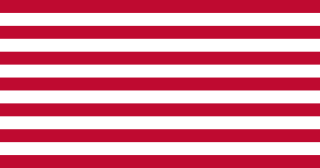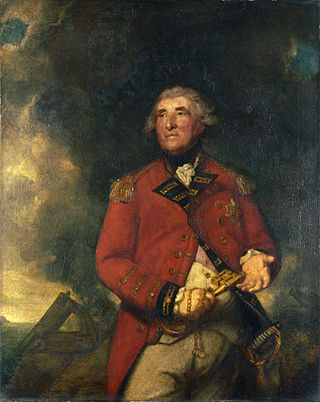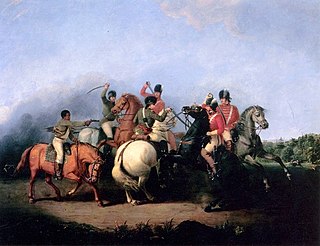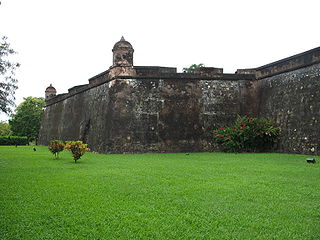Contents
Other years |
| Countries of the United Kingdom |
| Scotland |
| Sport |
| 1779 English cricket season |
Events from the year 1779 in Great Britain.
Other years |
| Countries of the United Kingdom |
| Scotland |
| Sport |
| 1779 English cricket season |
Events from the year 1779 in Great Britain.


1779 (MDCCLXXIX) was a common year starting on Friday of the Gregorian calendar and a common year starting on Tuesday of the Julian calendar, the 1779th year of the Common Era (CE) and Anno Domini (AD) designations, the 779th year of the 2nd millennium, the 79th year of the 18th century, and the 10th and last year of the 1770s decade. As of the start of 1779, the Gregorian calendar was 11 days ahead of the Julian calendar, which remained in localized use until 1923.

The Battle of Cape St. Vincent was a naval battle that took place off the southern coast of Portugal on 16 January 1780 during the American Revolutionary War. A British fleet under Admiral Sir George Rodney defeated a Spanish squadron under Don Juan de Lángara. The battle is sometimes referred to as the Moonlight Battle because it was unusual for naval battles in the Age of Sail to take place at night. It was also the first major naval victory for the British over their European enemies in the war and proved the value of copper-sheathing the hulls of warships.

The Continental Navy was the navy of the Thirteen Colonies during the American Revolutionary War. Founded on October 13, 1775, the fleet developed into a substantial force throughout the Revolutionary War, owing partially to the efforts of naval patrons within the Continental Congress. These congressional patrons included the likes of John Adams, who served as the chairman of the Naval Committee until 1776, when Commodore Esek Hopkins received instruction from the Continental Congress to assume command of the force.

The siege of Charleston was a major engagement and major British victory in the American Revolutionary War, fought in the environs of Charles Town, the capital of South Carolina, between March 29 and May 12, 1780. The British, following the collapse of their northern strategy in late 1777 and their withdrawal from Philadelphia in 1778, shifted their focus to the North American Southern Colonies. After approximately six weeks of siege, Major General Benjamin Lincoln, commanding the Charleston garrison, surrendered his forces to the British. It was one of the worst American defeats of the war.

General George Augustus Eliott, 1st Baron Heathfield, was a Scottish officer of the British Army, who served in three major wars during the 18th century. He rose to distinction during the Seven Years' War when he fought in Germany and participated in the British attacks on Belle Île (France) and Cuba. Eliott is most notable for his command of the Gibraltar garrison during the Great Siege of Gibraltar, which lasted from 1779 to 1783, during the American War of Independence. He was celebrated for his successful defence of the fortress and decisive defeat of Spanish and French attackers.
Nathaniel Fanning was an officer in the Continental Navy and later the United States Navy, who served aboard Bonhomme Richard during its 1779 battle with HMS Serapis.

French involvement in the American Revolutionary War of 1775–1783 began in 1776 when the Kingdom of France secretly shipped supplies to the Continental Army of the Thirteen Colonies upon its establishment in June 1775. France was a long-term historical rival with the Kingdom of Great Britain, from which the Colonies were attempting to separate.

The Great Siege of Gibraltar was an unsuccessful attempt by Spain and France to capture Gibraltar from the British during the American Revolutionary War. It was the largest battle in the war by number of combatants.

The southern theater of the American Revolutionary War was the central theater of military operations in the second half of the American Revolutionary War, 1778–1781. It encompassed engagements primarily in Virginia, Georgia, North Carolina, and South Carolina. Tactics consisted of both strategic battles and guerrilla warfare.

The Battle of Cape Spartel was an indecisive naval battle between a Franco-Spanish fleet under Admiral Luis de Córdova y Córdova and a British fleet under Admiral Richard Howe. These forces met on 20 October 1782 after Howe successfully resupplied Gibraltar, then under siege by Bourbon forces during the American Revolutionary War.

The Defeat of the Floating Batteries at Gibraltar is the title of a 1791 oil-on-canvas painting by Boston-born American artist John Singleton Copley. It depicts a coastal view of the naval action of the Great Siege of Gibraltar, part of the European theatre of the American Revolutionary War. The Spanish Empire's infamous floating batteries lie crippled and aflame in the background, while the shoreward waters are choked with surrendering Spaniards. The British rescue efforts are commanded from horseback by the Governor of Gibraltar, General George Augustus Eliott.
The Armada of 1779 was a combined Franco-Spanish naval enterprise intended to divert British military assets, primarily of the Royal Navy, from other war theatres by invading the Kingdom of Great Britain during the American Revolutionary War. This action was a part of the wider Anglo-French War (1778–1783). The proposed plan was to seize the Isle of Wight and then capture the British naval base of Portsmouth. Ultimately, no fleet battles were fought in the Channel and the Franco-Spanish invasion never materialized. This threat to Great Britain prompted comparisons to the earlier Spanish Armada of 1588.

The Battle of San Fernando de Omoa was a short siege and battle between British and Spanish forces fought not long after Spain entered the American Revolutionary War on the American side. On the 16 October 1779, following a brief attempt at siege, a force of 150 British soldiers and seamen assaulted and captured the fortifications at San Fernando de Omoa in the Captaincy General of Guatemala on the Gulf of Honduras.
Events from the year 1779 in the United States.

The action of 8 January 1780 was a naval encounter off Cape Finisterre between a British Royal Naval fleet under Admiral Sir George Rodney, and a fleet of Spanish merchants sailing in convoy with seven warships of the Guipuzcoan Caracas Company, under the command of Commodore Don Juan Augustin de Yardi. During the action the entire Spanish convoy was captured. Rodney's fleet was en route to relieve Gibraltar, and this action took place several days before Rodney's engagement and defeat of a Spanish fleet at the Battle of Cape St. Vincent.

The action of 14 September 1779 was a minor naval engagement that occurred on 14 September 1779, off the Azores between the Royal Navy frigate HMS Pearl under the command of George Montagu and the Spanish Navy frigate Santa Mónica under the command of Miguel de Nunes, with the Pearl capturing the Santa Mónica after a brief engagement. The battle was an episode during the American Revolutionary War, where American rebels under the overall command of George Washington launched a revolution against the British government based on perceived grievances. Spain, having been handed a humiliating defeat during the Seven Years' War by the British, was eager to enter the war on the side of the Americans to regain the territories they had lost, such as Florida, Menorca and Gibraltar. British and Spanish naval forces engaged each other several times during the war, as the conflict spilled over into Europe with the Spanish laying siege to Gibraltar.
James Coutts Crawford was an officer in the Royal Navy who served during the American War of Independence and the French Revolutionary and Napoleonic Wars.

The Anglo-French War, also known as the War of 1778 or the Bourbon War in Britain, was a military conflict fought between France and Great Britain, sometimes with their respective allies, between 1778 and 1783. As a consequence, Great Britain was forced to divert resources used to fight the American War of Independence to theatres in Europe, India, and the West Indies, and to rely on what turned out to be the chimera of Loyalist support in its North American operations. From 1778 to 1783, with or without their allies, France and Britain fought over dominance in the English Channel, the Mediterranean, the Indian Ocean and the Caribbean.

The Capture of HMS St. Fermin was a naval engagement that took place off Málaga on 4 April 1781, during the American Revolutionary War. Spanish xebecs San Antonio and San Luis captured the sloop-of-war HMS St. Fermin.